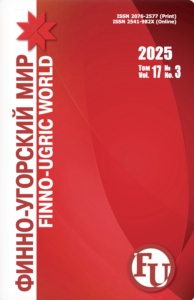Sculptural compositions based on Mordovian choreography: an innovative aspect
Burnaev Alexander G.,
Doctor of Arts, Professor, Head of the Department of National Choreography,
Ogarev Mordovia State University (Saransk, Russia), burnaevag@mail.ru
Levina Ekaterina V.,
Master student of Pedagogical Education, Saratov National Research University named after N. G. Chernyshevsky (Saratov, Russia), catherine1995@yandex.ru
Introduction. The article considers the problem of introducing national themes. This problem is relevant for higher education. The novelty of the study can be seen in the title of the article. The innovative aspect is supported by a practical example, that is, a stage version of a choreographic work, which is significant for art history and pedagogical sciences. The article contains a full analysis of the ballet suite “Sculptural compositions based on Mordovian choreography”, presented in 2016 in Ogarev Mordovia State University.
Materials and Methods. The object of research is an innovative aspect of the choreographic work “Sculptural compositions based on Mordovian choreography”. The subject of the research is the staging synthesis of the plastic characteristics of Mordovian ethnic sculptures and their stylization. The aim of the research is to approbate the results of the choreographic work “Sculptural compositions based on Mordovian choreography”. Experimental, descriptive, analytical methods of research are used in the work for art, cultural and pedagogical analysis.
Results and Discussion. The results of the research show that the contemporary stage decision of a choreographic work not only helps to perceive living statues, composed by a choreographer, like real ones, it broadcasts the stage “avant-garde”, reflects the credibility of ethnic Mordovians. Applying this technique, the crude statics of the Mordovinian statues seem softer. Discussion of scenic works, their comparison with previous similar works confirms the hypothesis of the systematization of the author’s material and the implementation of the innovative approach in the practice of Mordovian choreography.
Conclusion. Traditional modern production in repertory politics against the background of existing national choreographic works in the modernist style are the basis of the creative work of the bands in Mordovia. In the prism of the production work, the proposed material can be used for acquaintance and practical application.
Key words: ballet suite; sculptural composition; sculptural plastic; choreographic production; choreographic miniature; choreographic text.
For citation: Burnaev AG, Levina EV. Skul’pturnye kompozicii na osnove mordovskoj horeografii: innovacionnyj aspekt [Sculptural compositions based on Mordovian choreography: an innovative aspect]. Finno-ugorskiy mir = Finno-Ugric World. 2017; 1: 102–109. (In Russ.)
- Bryzhinsky VS. Serebrjanye cepochki [Silver chains]. Saransk: Mordov. kn. izd-vo; 2002. (In Russ.)
- Burnaev AG. Mordovskij tanec v kontekste finno-ugorskoj tanceval’noj kul’tury: monografija [Mordovian dance in the context of the Finno-Ugric dance culture: monograph]. Saransk: Mordov. kn. izd-vo; 2014. (In Russ.)
- Burnaev AG. Ogjust Roden – Stepan Jer’zja: skul’ptura i horeograficheskaja plastika [Auguste Rodin – Stepan Erzya: sculpture and choreographic plastics]. Centr i periferija= Center and periphery. 2014; 3: 74–81. (In Russ.)
- Burnaev AG. «Jekzot» tanca O. Rodena i «neestestvennost’» baletnogo rakursa S. D. Jer’zi [“Exot” of O. Rodin’s dance and “unnaturalness” of the ballet perspective S. D. Erzya]. Finno-ugorskiy mir= Finno-Ugric World. 2013; 3: 67–74. (In Russ.)
- Yesenin SA. Stihotvorenija i pojemy [Poems and poems]. Sobranie sochinenij v 5 tomah= Collected works in 5 volumes. Moskva; 1961; 1. (In Russ.)
- Yesenin SA. Ne zhaleju, ne zovu, ne plachu: stihotvorenija, pojemy [I do not regret, I do not call, I do not cry: poems]. Moskva: Eksmo; 2005. (In Russ.)






















